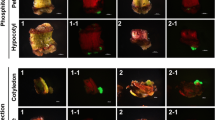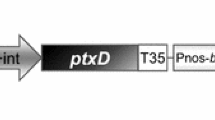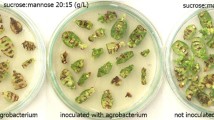Abstract
Despite the significant advantages of using herbicide resistance for selection of genetically engineered plants, alfalfa transformation has relied primarily on selection for antibiotic resistance. In the few studies reporting the use of resistance to the herbicide phosphinothricin (PPT), transformation efficiencies were low. The present investigation describes a PPT-based selection system for alfalfa transformation that uses the phosphinothricin acetyl-transferase (pat) gene as a selectable marker and 5.0 mg l−1 of bialaphos as the selective agent. The method achieves transformation efficiencies, measured as the percentage of explants giving rise to one or more transformed plantlets, greater than 50%. These plantlets accumulated detectable amounts of PAT at levels varying from 2 to 1367 pg μg−1 total protein. Transformed plants transferred to soil in the greenhouse were phenotypically normal and exhibited resistance to bialaphos leaf painting at 5 g l−1 and applications of PPT equivalent to field-level use (0.5 kg ha−1).





Similar content being viewed by others
Abbreviations
- CsVMV:
-
Cassava vein mosaic virus
- GA:
-
Ammonium glufosinate
- GS:
-
Glutamine synthetase
- PAT:
-
Phosphinothricin acetyl-transferase
- PPT:
-
Phosphinothricin
- SAS:
-
SAS/STAT™ statistical software
References
Agbios (2006) AgBios Biotech Crop Database. The AGBIOS Company, Ontario, Canada. http://www.agbios.com, cited 15 October 2006
Barbulova A, Lantcheva A, Zhiponova M, Vlahova M, Atanassov A (2002) Agrobacterium-mediated transformation for engineering of herbicide-resistance in alfalfa (Medicago sativa L.). Biotech Biotechnol Equip 16:21–27
Bingham ET (1991) Registration of alfalfa hybrid Regen-SY germplasm for tissue culture and transformation research. Crop Sci 31:1098–1106
Brown DC, Atanassov A (1985) Role of genetic background in somatic embryogenesis in Medicago. Plant Cell Tiss Org Cult 4:111–122
D’Halluin K, Botterman J, De Greef W (1990) Engineering of herbicide-resistant alfalfa and evaluation under field conditions. Crop Sci 30:866–871
D’Halluin K, De Block M, Denecke J, Jannsens J, Leemans J, Reynaerts A, Botterman J (1992) The bar gene as selectable and screenable marker in plant engineering. Methods Enzymol 216:415–426
Gamborg OL, Miller RA, Ojima K (1968) Nutrient requirements of suspension cultures of soybean root cells. Exp Cell Res 50:151–158
Hess FD (2000) Light-dependent herbicides: an overview. Weed Sci 48:160–170
Miki B, McHugh S (2004) Selectable marker genes in transgenic plants: applications, alternatives and biosafety. J Biotechnol 107:193–232
Murashige T, Skoog F (1962) A revised medium for rapid growth and bioassays with tobacco tissue cultures. Physiol Plant 15:473–497
Norris SR, Meyer SE, Callis J (1993) The intron of Arabidopsis thaliana polyubiquitin genes is conserved in location and is a quantitative determinant of chimeric gene expression. Plant Mol Biol 21:895–906
Ontario Ministry of Agriculture, Food (OMAF) (2004) Guide to weed control 2004–2005. The Government of Ontario, Ontario, Canada
Schenk RV, Hildebrandt AC (1972) Medium and techniques for induction and growth of monocotyledonous and dicotyledonous plant cell cultures. Can J Bot 50:199–204
Strauch E, Wohlleben W, Pühler A (1988) Cloning of a phosphoinothricin N-acetyltransferase gene from Streptomyces viridochromogenes Tü494 and its expression in Streptomyces lividans and Escherichia coli. Gene 63:65–74
Stuart DA, Strickland SG (1984) Somatic embryogenesis from cell cultures of Medicago sativa L., I. The role of amino acid additions to the regeneration medium. Plant Sci Lett 34:165–174
Tabe LM, Wardley-Richardson T, Ceriotti A, Aryan A, McNabb W, Moore A, Higgins TJV (1995) A biotechnological approach to improving the nutritive value of alfalfa. J Anim Sci 73:2752–2759
Verdaguer B, de Kochko A, Beachy RN, Fauquet C (1996) Isolation and expression in transgenic tobacco and rice plants, of the cassava vein mosaic virus (CVMV) promoter. Plant Mol Biol 31:1129–1139
Wang H, Qi M, Cutler AJ (1993) A simple method of preparing plant samples for PCR. Nucleic Acids Res 21:4153–4154
Ziauddin A, Lee RWH, Lo R, Shewen P, Strommer J (2004) Transformation of alfalfa with a bacterial fusion gene, Mannheimia haemolytica A1 leukotoxin50-gfp: response with Agrobacterium tumefaciens strains LBA4404 and C58. Plant Cell Tiss Org Cult 79:271–278
Acknowledgements
The technical assistance of Penny Slack and Michelle Daigneault, and the continued encouragement and guidance of our collaborators Drs. Patricia Shewen and Reggie Lo, are gratefully acknowledged. We thank Drs. S. Austin-Phillips and D. Samac for sharing materials and information. We are also appreciative of the significant editorial contributions of an anonymous reviewer. Financial support was provided by Dow AgroSciences Canada Inc, the National Science and Engineering Research Council of Canada, and the Ontario Ministry of Agriculture, Food and Rural Affairs. This work was in partial fulfillment of requirements for the M.Sc. degree of AM.
Author information
Authors and Affiliations
Corresponding author
Rights and permissions
About this article
Cite this article
Montague, A., Ziauddin, A., Lee, R. et al. High-efficiency phosphinothricin-based selection for alfalfa transformation. Plant Cell Tiss Organ Cult 91, 29–36 (2007). https://doi.org/10.1007/s11240-007-9274-8
Received:
Accepted:
Published:
Issue Date:
DOI: https://doi.org/10.1007/s11240-007-9274-8




